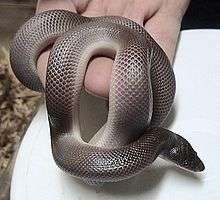Loxocemus
| Loxocemidae | |
|---|---|
 | |
| Scientific classification | |
| Kingdom: | Animalia |
| Phylum: | Chordata |
| Class: | Reptilia |
| Order: | Squamata |
| Suborder: | Serpentes |
| Family: | Loxocemidae Cope, 1861 |
| Genus: | Loxocemus Cope, 1861 |
| Species: | L. bicolor |
| Binomial name | |
| Loxocemus bicolor Cope, 1861 | |
| Synonyms | |
| |
The Loxocemidae are a monotypic family[2] of snakes created for the monotypic genus Loxocemus[4] that contains the species L. bicolor found in Mexico and Central America. Loxocemidae is one of the smallest snake families, having just one species and one genus. No subspecies are currently recognized.[5] Analyses of DNA show that Loxocemus is most closely related to the Pythonidae.
Description
Adults grow to a maximum of 1.57 m (62 in) in length.[6] On average this snake grows to roughly 91 cm (2.99 ft). The body is stout and very muscular. The snout is shovel-shaped, with a narrow head and small eyes to facilitate burrowing. The species is described as terrestrial and semi-fossorial,[6] which makes them hard to observe and study. The color pattern is usually dark with patches of white scales, although occasionally after shedding all pigment will disappear, resulting in a white snake with only a small dark patch on its head.
Distribution and habitat
It is found along the Mexican Pacific versant at low to moderate elevations in the states of Nayarit, Jalisco, Colima, Michoacán, Morelos, Guerrero, Oaxaca, and Chiapas. From there, its range extends south through Guatemala, Honduras, El Salvador, Nicaragua, and Costa Rica. The type locality given is "La Unión, San Salvador" (in El Salvador).[1]
Lifecycle
They are found in a variety of habitats, including tropical, moist, and dry forests. In Honduras and Guatemala, they also occur in dry inland valleys that drain into the Caribbean.[1] Their diet is believed to consist of rodents and lizards. They have also been observed eating iguana eggs. They are oviparous, laying small clutches of two to four eggs.[6]
See also
- Loxocemidae by common name
- Loxocemidae by taxonomic synonyms
- List of snakes, overview of all snake families and genera
References
- 1 2 3 4 5 McDiarmid RW, Campbell JA, Touré T. 1999. Snake Species of the World: A Taxonomic and Geographic Reference, vol. 1. Herpetologists' League. 511 pp. ISBN 1-893777-00-6 (series). ISBN 1-893777-01-4 (volume).
- 1 2 "Loxocemidae". Integrated Taxonomic Information System. Retrieved 17 August 2007.
- ↑ Species Loxocemus bicolor at The Reptile Database. Accessed 17 August 2007.
- ↑ "Loxocemus". Integrated Taxonomic Information System. Retrieved 17 August 2007.
- ↑ "Loxocemus bicolor". Integrated Taxonomic Information System. Retrieved 17 August 2007.
- 1 2 3 Loxocemidae at the Reptarium.cz Reptile Database. Accessed 3 November 2008.
Further reading
- Noonan, B. P. & Chippindale, P. T. (2006): Dispersal and vicariance: The complex evolutionary history of boid snakes. - Molecular Phylogenetics and Evolution 40: 347–358.
- Mattison, Chris (1999). Snake. DK Publishing. ISBN 0-7894-4660-X.
External links
| Wikimedia Commons has media related to Loxocemus bicolor. |
- Loxocemus bicolor at the Reptarium.cz Reptile Database. Accessed 19 August 2007.
- Family loxocemidae